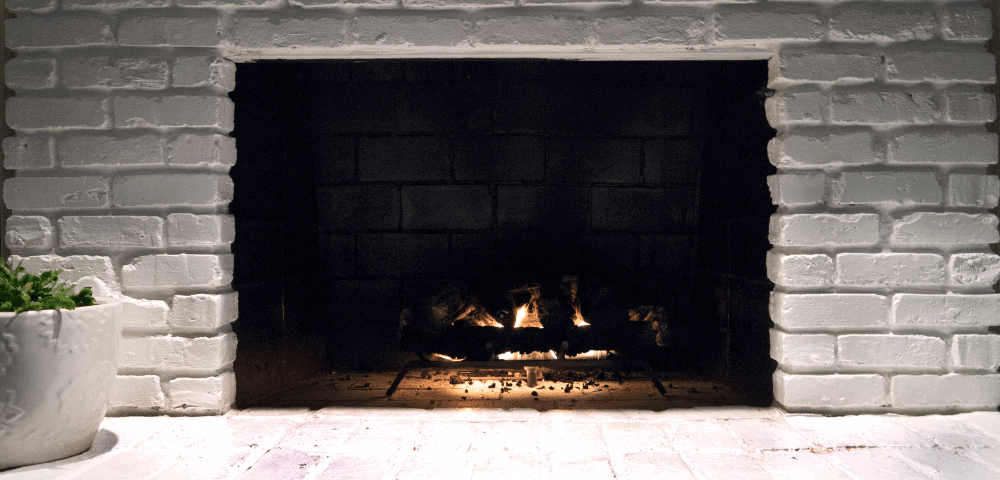It is no secret that a white brick fireplace makes a stunning addition to any home. In addition to amping up the look of your home, this appliance keeps you warm on any cold night.
Although it’s resourceful, a white fireplace isn’t immune to the challenges that come with installing such a feature.
One particular issue that a lot of homeowners struggle with is how to keep their fireplaces clean. To help you out, we’ve highlighted the best ways to clean a white brick fireplace.
Read on to learn more.
How do you clean white painted brick?
The easiest way to get all the soot from your white brick fireplace is by using a solution of baking soda.
All you need to do is mix equal parts of water and baking soda to create a thick paste. Then, rub the mixture on the fireplace. Give it some time to soak in before rinsing it off.
If you’re looking to remove all kinds of dirt from your brick fireplace, here are some other solutions you can try.
Steps for cleaning fireplace bricks
1. Clear out the fireplace
To clean fireplace brick, you should start by clearing out the entire section.
This entails getting rid of any loose soot, dust, debris, or small-sized particles from the brick’s face. You can use either a rag or the soft brush attachment of your vacuum cleaner for this.
2. Wet bricks
The next step requires you to wet the bricks.
Once you’ve cleared out, look for a spray bottle and fill it with some water. You can then use it to wet the bricks. If you don’t have a spray bottle, you can use a masonry sponge instead.
Given how messy it can get, it’s important that you remove any delicate decorations beforehand to avoid soaking them in water. It’s also a good idea to cover the flooring with either a towel or tarp.
Is it necessary to wet the bricks before cleaning them?
Yes, this is crucial for two reasons. For one, it completely eliminates any loose dust that was left from the previous step.
Secondly, the moisture from the water-filled spray bottle acts as a protective barrier.
So when you finally use your preferred cleaning solution, it doesn’t seep into the brick’s interior. If this happens, your white fireplace bricks may end up getting stained or worse, discolored.
3. Choose a cleaning solution
This is where things get somewhat tricky. There are numerous cleaning solutions that you can use to clean a brick fireplace. These range from baking soda to dish soap, vinegar, and more.
The process required to clean fireplace bricks with each of these solutions is different. To make your work easy, here are detailed step-by-step guides:
Cleaning a brick fireplace with dish soap
The good thing about this approach is that dish soap is readily available at home. Follow these steps:
- Mix equal parts of the dishwashing detergent and baking soda or table salt with water. An ounce of the dish soap and table salt should be enough to create a cream-like solution. Be careful not to use too much water as it can dilute the cleanser and compromise its efficiency.
- Use a dish towel or rag to cover the bricks with your newly-created cleanser.
- Allow it to soak for no less than 10 minutes.
- Once it’s soaked in, scrub the fireplace bricks in a circular motion. A bristle brush will make quick work of this. And while you’re at it, ensure that you’re working from the top down.
- For a more effective scrubbing action, feel free to spray more water into the cleaning mixture.
- Finally, rinse off the solution and wipe.
Cleaning a brick fireplace with vinegar
Like the dishwashing detergent, vinegar is another cleanser that’s very easy to find. Even if you don’t have it at home, you can buy one from your nearest home improvement stores.
It’s particularly effective at breaking down any dirt that’s built up on your white fireplace bricks. Follow these steps:
- The first thing you should do is mix equal parts vinegar – preferably white vinegar – with warm water.
- Fill your spray bottle with the mixed solution and spray it on your bricks. Start by spraying the bricks on the inside then proceed to the exterior.
- Allow the vinegar solution to soak in for about 2 to 5 minutes.
- Then using your bristle brush, scrub in a circular motion. This time around, consider working from the outside in.
- Rinse and wipe the bricks.
- To neutralize the acidity effects of the vinegar, mix a few tablespoons of baking soda with water in a different spray bottle.
- Spray the bricks then leave them to dry.
Cleaning a fireplace brick with scrubbing bubbles
When you think of getting your fireplace bricks clean, scrubbing bubbles isn’t the first thing you think about. But, they do a pretty amazing job.
- Start by spraying the scrubbing bubbles directly on the fireplace bricks.
- Let it sit for anywhere between ¼ and ½ an hour.
- Put your scrub brush in water and use this to scrub the bricks in a circular motion.
- Finish off by wiping, rinsing then drying. Remember to use a clean cloth different from the wet rag you used to rinse the bricks.
4. Spot-clean any remaining stains
It’s not unusual to have a few soot stains left after cleaning with the solutions recommended above.
If this happens, just go back and spot-clean the sooty area. The best product to use at this point is a mixture of cream of tartar and water. Spray or apply it to the stain, and let it sit for a few minutes before scrubbing with a brush.
5. Use the right wood for your fireplace
Moving forward, you’ll want to ensure that you’re burning the right kind of wood. Using wood that burns clean and hot will is the easiest way to keep your white brick fireplaces looking pristine.
This brings us to the question, “what’s the best firewood to use for a white fireplace?” Well, the most important condition is that the wood should be well-seasoned.
This means that the wood has had enough drying time to get rid of all the moisture content present.
Can you use ammonia for cleaning a fireplace?
Yes, you can use ammonia to clean the fireplace.
However, you should only resort to this cleaning solution if your fireplace is fairly new. Ammonia can have a pretty adverse effect on old, fragile bricks. So it’s good to avoid it if you aren’t sure of the outcome.
If you deem it safe to use, take the following steps:
- Start by donning protective gear like rubber gloves and eye protection wear.
- In a container, combine a half cup of ammonia with a quarter cup of dish detergent.
- Then add in three to four cups of hot water and stir vigorously.
- Spray this hot water solution on your white bricks.
- Scrub the bricks with a scrub brush, then rinse and wipe the area clean with a damp cloth.
Are there any other supplies for cleaning fireplace brick?
Baking soda, dish soap, scrubbing bubbles, and ammonia aren’t the only cleaning solutions you can use. The two other compounds you can use are trisodium phosphate and borax.
Using borax to clean fireplace brick
- Fill a container with about four cups of water and add two tablespoons of borax to it.
- Transfer the solution into a spray bottle.
- Use this to spray small portions of the fireplace at a time.
- After spraying, scrub with a bristle brush then wipe them clean with a damp cloth.
Using trisodium phosphate (TSP) to clean fireplace brick
While effective, TSP cannot be used to clean just any fireplace bricks.
If you’re using naturally white bricks, then it will work just fine. However, if you have bricks that were painted recently, you’ll want to steer clear of TSP. Because it’s so strong, it can peel paint, forcing you to paint your bricks from scratch.
Here are the steps to follow when cleaning with TSP:
- Add about an eighth cup of TSP to a gallon of hot water. Consider using a big bucket so as to prevent the solution from spilling.
- Place your scrub brush in the solution and begin scrubbing the bricks.
- Using a warm, wet rag, rinse the bricks and leave them to dry.
If you resort to this approach, be sure to handle the trisodium phosphate with extreme care as it’s slightly toxic. This means donning protective gear like rubber gloves, glasses, and a respiratory mask.
Conclusion
There are a couple of things you should consider before choosing a method to clean fireplace bricks.
One such factor is the age of your fireplace. If you’re dealing with older bricks, then avoid using cleansers like trisodium phosphate that can peel paint.
You’ll also want to consider just how dirty the fireplace bricks are. For more stubborn stains, a simple solution of dish soap and plain water won’t cut it. Rather, go for stronger cleansers like borax or ammonia.
Ultimately, the easiest way to keep your precious fireplace pristine is to use the right firewood. Specifically, well-seasoned firewood burns cleaner, resulting in clean soot. This then makes cleaning the bricks easier as there aren’t any stubborn stains to deal with.


